 Last night Apple launched 3 new products (as we briefly noted). A new versionof iTunes, updated iMacs and as expected, a video-enabled iPod.
Last night Apple launched 3 new products (as we briefly noted). A new versionof iTunes, updated iMacs and as expected, a video-enabled iPod.
New iMac G5
They’re faster and thinner (and the 20″ version is cheaper than itsprevious incarnation). They now include an iSight (video camera) builtinto the unit and come with new software “Front Row” which include anIR remote, looking suspiciously like an iPod shuffle which attaches tothe side of the iMac (the IR receiver is allegedly hidden behind theApple logo).
Already considered a design classic, the new iMacs look even better, butin reality though Apple have added more power for the buck, they’rejust iMacs. However the real innovation is Front Row which is designed to directly compete with Microsoft’s Media PC, and it does this by using Apple iLife applications being simple to use and control(the Microsoft Media PC has 24+ buttons, the Apple remote has 6).
 Front Row gives extremely simple access to content stored on the iMacincluding music through iTunes, videos (including the newly availablevideo content that’s available through iTunes), photos stored in iPhotoand DVD’s though iDVD. The remote works up to 30 feet away from theunit.
Front Row gives extremely simple access to content stored on the iMacincluding music through iTunes, videos (including the newly availablevideo content that’s available through iTunes), photos stored in iPhotoand DVD’s though iDVD. The remote works up to 30 feet away from theunit.
Currently Apple are not saying whether Front Row will be available asan upgrade for existing Mac users, however the new universal iPod dockdoes have an IR receiver on the front and the remote is available as aseparate purchase so an educated guess would be that it will be.
The iSight is a nice addition (the add-on version costs over GBP 100),but it’s a fantastic webcam. It obviously works with iChat (Apple’s IMsystem) allowing video conferencing with up to 3 other people, andthere’s now Photo Booth which allows snap-shots to be taken and thenmanipulated by adding effects etc.
Both the 17″ and 20″ come with 8x SuperDrives which are now dual-layer(DVD+R DL/DVD+-RW/CD-RW), they have a PCI-X bus (faster than the oldPCI bus) and PCI-X video cards (17″ is a Radion X600 PRO and the 20″ aX60 PRO XT). Both come with 512MB RAM expandable to 2.5GB, the 17″ witha 160GB SATA disk and 20″ with 250GB. CPU speeds have been upped to1.9GHz (17″) and 2.1GHz (20″). UK pricing starts at GBP 899 (inc VAT)for the 17″ and GBP 1,199 for the 20″.
 Since there’s no base unit (everything is built into the actualdisplay) the amount is space they require is minimal. They’d look justas good on a desk as in the living room.
Since there’s no base unit (everything is built into the actualdisplay) the amount is space they require is minimal. They’d look justas good on a desk as in the living room.
Video-capable iPod
The 5th generation iPod is here, though probably not what manyexpected. It’s just a prettier, thinner version of the iPod Photo witha larger screen (now 2.5″). The iPod’s lines are now much closer tothat of the new iMacs (excepting the click wheel and of course it nowgenerally available in black as well as white).
The screen is crisp, clear and remarkably bright, though it’s only320 x 240 resolution, which is good enough to watch music videos andsuch like, but rather small compared to other devices on the market.However album art, podcasts etc. with some aspect of video (or photo)content does look very good. Though Apple have probably alreadydeveloped a widescreen video iPod, why launch it now just to give thecompetition a chance to catch-up? The new iPod is a step change overexisting versions and everyone is again going to have to compete withit.
Currently video can only be imported through iTunes (like photos),however this is likely to be a move to appease the movie studios.Whether they’ll be an upgrade to iTunes to import (noncopyright/encrypted) video content is yet to be seen, it might nothappen for a while. The iPod plays MPEG4 and H.264 video content.
If the iPod is plugged into a dock, the video can be sent to anexternal display like a TV, but it’s still only sent at 320 x 240 whichlooks pixelated.
There are a few extras in-line with the nano, such as extra clocks,being able to lock the unit, more games etc. A real improvement is thecalendar application which suits the new display perfectly.
Pricing is GBP 219 for the 30GB version and GBP 299 for 60GB (both incVAT).
iTunes 6
 iTunes 5 was launched with the iPod nano, and a month later there’s nowiTunes 6 to go with the 5th generation model. The main new advance isvideo content, there are now around 2000 music videos available on theiTunes music store (unfortunately there’s still a huge pricedifferential between the US and UK with a music video costing $1.99 inthe US and GBP 1.89 in the UK – with the UK getting panned on price, as usual).
iTunes 5 was launched with the iPod nano, and a month later there’s nowiTunes 6 to go with the 5th generation model. The main new advance isvideo content, there are now around 2000 music videos available on theiTunes music store (unfortunately there’s still a huge pricedifferential between the US and UK with a music video costing $1.99 inthe US and GBP 1.89 in the UK – with the UK getting panned on price, as usual).
Since Steve Jobs (CEO of Apple) is also CEO of Pixar (the animationcompany that made Finding Nemo, The Incredibles etc) there’s 6 PixarShorts also available for purchase on the iTunes store (same price as amusic video).
In the US there’s also terrestrial TV shows available from ABC and theDisney Channel (Lost, Desperate Housewives and others). Why may TVshows available as downloads when you can buy DVD sets? Because itgives revenue for PVR opportunities i.e. it’s unlikely someone willdownload every episode of Lost, but they will download and pay for theepisode they missed last night (and can watch it on their hour commuteto work), iTunes makes it incredibly easy to do this, rather thanworking out how to set your PVR, and then getting the content off it.Though content can be watched through iTunes, it’s likely more peoplewill use it with their iPod.
It’s somewhat odd that Apple are working with Disney as Pixar have beenvery publicly rowing with Disney over distribution agreements fortheir films. What people forget is that Pixar are contracted to make 6new films for Disney, so assuming that’s one a year that’s 6 years tosettle the arguments (even lawyers can work to those timescales). It’sjust a matter of money, Pixar want more and Disney don’t want to payit. By the time 6 years are up it’s likely they’ll be buddies again andboth with have reached a happy compromise.
 The video aspects of the iTunes store, though limited at the moment,are a major break-through (even ground-breaking) especially with thecurrent shows being available. Disney obviously have a huge amount ofcontent they could make available if all the legal intricacies can besorted. Once one studio cracks, they’ll all follow suit.
The video aspects of the iTunes store, though limited at the moment,are a major break-through (even ground-breaking) especially with thecurrent shows being available. Disney obviously have a huge amount ofcontent they could make available if all the legal intricacies can besorted. Once one studio cracks, they’ll all follow suit.
It shows how successful iTunes is considering that arch rivals Realand Microsoft have just made an agreement to share technology etc andjoin forces rather than fighting with each other to try and expand the25% of the market they JOINTLY command.
There’s some other new features of iTunes, gifting which allows anyoneto give away a track, albums, music videos or their playlists to anyother registered iTunes user (i.e. the gifter purchases it and it’smade available to another user for download).
Just for You is in beta, whereby iTunes suggest purchases based onprevious behaviour – a suggestion engine.
One of the most request features for podcasts has been user ratings andthis is now available, so like a podcast you can now rate it and themore ratings it get, the higher up the listings it goes.
Considering Apples future
 Apple’s future has definitely been shaped by the iPod (they sold 1mNanos in 17 days – how many returned was, not surprisingly undefined) which is molding how the company moves forward.
Apple’s future has definitely been shaped by the iPod (they sold 1mNanos in 17 days – how many returned was, not surprisingly undefined) which is molding how the company moves forward.
Macsare becoming companions for iPods rather than the other way around. Keyto all of this is content and iTunes is definately leading the way with75%+ market share (globally) and higher in specific markets (UK it’sover 85%).
If Apple can crack the video market, they’re going to dominate for along time, and though the 5Gen iPod is a step in the right direction,it’s just that. Though Apple never pre-announce products you can besure the 6Gen and even 7Gen iPods are already designed and waiting in thewings and they’ll be full blown widescreen systems.
Macs are going to change as Apple move away from IBM Power processorsto Intel CPUs, but that’s an internal change and they’ll stillergonomically beat the pants of almost everything else out there.
Apple
 Sky have been mulling about an IPTV service for a while. They were in discussions with THUS who provide the telecoms back-end for their SkyTalk service and helped Sky with their WapTV services, they were talking about doing an IPTV trial with THUS, but THUS pulled out of the LLU arena due to lack of cash. They were looking at spending £20m+ on just a trial.
Sky have been mulling about an IPTV service for a while. They were in discussions with THUS who provide the telecoms back-end for their SkyTalk service and helped Sky with their WapTV services, they were talking about doing an IPTV trial with THUS, but THUS pulled out of the LLU arena due to lack of cash. They were looking at spending £20m+ on just a trial.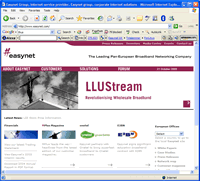 Sky have got the resources to bolster a depressed telecoms market and put the necessary cash into a company to achieve a reasonable roll-out. Of course they also have the content that consumers want. If another “triple-play” broadband provider wants to get into the game (including BT Retail), Sky can make it very difficult for them by not licensing Sky content (of course Ofcom may force them to, as they have done in the cable industry).
Sky have got the resources to bolster a depressed telecoms market and put the necessary cash into a company to achieve a reasonable roll-out. Of course they also have the content that consumers want. If another “triple-play” broadband provider wants to get into the game (including BT Retail), Sky can make it very difficult for them by not licensing Sky content (of course Ofcom may force them to, as they have done in the cable industry).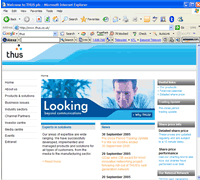 Sky are also in an odd position as they’ll probably utilise MPEG-4 as the coding system, which means they’ll have to modify (or supplement) their existing transmission systems which are all based on MPEG-2. They’ll also have to introduce a new IP based set-top-box. However they’ll have to be carefull as to not make it too feature rich compared to existing STB’s used to decode the satellite transmissions or existing users will want to migrate to the broadband version – which will cost Sky a huge ammount as the exisitng boxes are considerably subsidised.
Sky are also in an odd position as they’ll probably utilise MPEG-4 as the coding system, which means they’ll have to modify (or supplement) their existing transmission systems which are all based on MPEG-2. They’ll also have to introduce a new IP based set-top-box. However they’ll have to be carefull as to not make it too feature rich compared to existing STB’s used to decode the satellite transmissions or existing users will want to migrate to the broadband version – which will cost Sky a huge ammount as the exisitng boxes are considerably subsidised. Last night Apple launched 3 new products (as we
Last night Apple launched 3 new products (as we 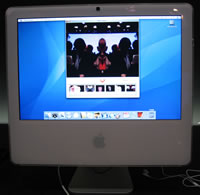 Front Row gives extremely simple access to content stored on the iMacincluding music through iTunes, videos (including the newly availablevideo content that’s available through iTunes), photos stored in iPhotoand DVD’s though iDVD. The remote works up to 30 feet away from theunit.
Front Row gives extremely simple access to content stored on the iMacincluding music through iTunes, videos (including the newly availablevideo content that’s available through iTunes), photos stored in iPhotoand DVD’s though iDVD. The remote works up to 30 feet away from theunit. Since there’s no base unit (everything is built into the actualdisplay) the amount is space they require is minimal. They’d look justas good on a desk as in the living room.
Since there’s no base unit (everything is built into the actualdisplay) the amount is space they require is minimal. They’d look justas good on a desk as in the living room. iTunes 5 was launched with the iPod nano, and a month later there’s nowiTunes 6 to go with the 5th generation model. The main new advance isvideo content, there are now around 2000 music videos available on theiTunes music store (unfortunately there’s still a huge pricedifferential between the US and UK with a music video costing $1.99 inthe US and GBP 1.89 in the UK – with the UK getting panned on price, as usual).
iTunes 5 was launched with the iPod nano, and a month later there’s nowiTunes 6 to go with the 5th generation model. The main new advance isvideo content, there are now around 2000 music videos available on theiTunes music store (unfortunately there’s still a huge pricedifferential between the US and UK with a music video costing $1.99 inthe US and GBP 1.89 in the UK – with the UK getting panned on price, as usual).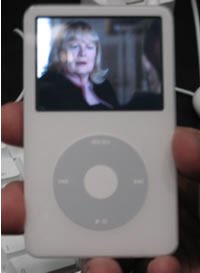 The video aspects of the iTunes store, though limited at the moment,are a major break-through (even ground-breaking) especially with thecurrent shows being available. Disney obviously have a huge amount ofcontent they could make available if all the legal intricacies can besorted. Once one studio cracks, they’ll all follow suit.
The video aspects of the iTunes store, though limited at the moment,are a major break-through (even ground-breaking) especially with thecurrent shows being available. Disney obviously have a huge amount ofcontent they could make available if all the legal intricacies can besorted. Once one studio cracks, they’ll all follow suit.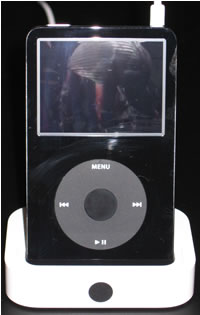 Apple’s future has definitely been shaped by the iPod (they sold 1mNanos in 17 days – how many returned was, not surprisingly undefined) which is molding how the company moves forward.
Apple’s future has definitely been shaped by the iPod (they sold 1mNanos in 17 days – how many returned was, not surprisingly undefined) which is molding how the company moves forward. BT has today set-up a new division, known as OpenReach. They’ve been under pressure from some time from competitors and regulators to curb their monopolistic tendencies (they still own over 85% if the infrastructure in the UK). There has even been talk of splitting BT up – although OfCom has currently reject this.
BT has today set-up a new division, known as OpenReach. They’ve been under pressure from some time from competitors and regulators to curb their monopolistic tendencies (they still own over 85% if the infrastructure in the UK). There has even been talk of splitting BT up – although OfCom has currently reject this.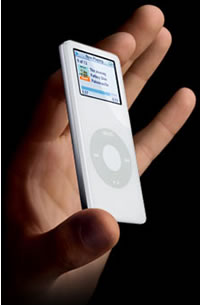 iTunes 5.0
iTunes 5.0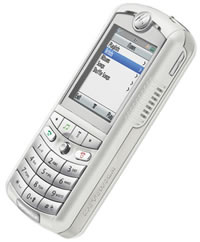 Motorola ROKR
Motorola ROKR PodGear PockParty
PodGear PockParty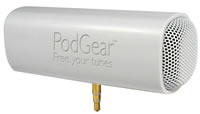 Is this something to buy? It’s VERY convenient as it’s so small and does easily fit in your pocket (as the name suggests) and it can be heard by a a group of people in the right surroundings.
Is this something to buy? It’s VERY convenient as it’s so small and does easily fit in your pocket (as the name suggests) and it can be heard by a a group of people in the right surroundings. Sony’s PlayStation Portable is a media hub, but unfortunately, apart from games there isn’t really any content available for it (not forgetting unlucky UK citizens who can’t even officially buy one until September).
Sony’s PlayStation Portable is a media hub, but unfortunately, apart from games there isn’t really any content available for it (not forgetting unlucky UK citizens who can’t even officially buy one until September). Using an Apple Mac has many advantages and ripping DVDs is one of them. Look for an application MacTheRipper, it does exactly what is says on the tin, and takes the MPEG2 information from a DVD while removing region coding, macrovision and other DVD annoyances and stores the resulting files on the hard disk.
Using an Apple Mac has many advantages and ripping DVDs is one of them. Look for an application MacTheRipper, it does exactly what is says on the tin, and takes the MPEG2 information from a DVD while removing region coding, macrovision and other DVD annoyances and stores the resulting files on the hard disk. Windows users don’t despair
Windows users don’t despair Last weekend there was a report that France Telecom (FT) were rumored to be buying Cable and Wireless (C&W) for GBP 4bn. FT has of course denied it.
Last weekend there was a report that France Telecom (FT) were rumored to be buying Cable and Wireless (C&W) for GBP 4bn. FT has of course denied it.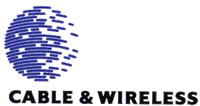 One area where they have invested in and have made real progress is Local Loop Unbundling (LLU) with their purchase of Bulldog (for GBP 18m). Bulldog have now unbundled about 400 exchanges and have plans to unbundle another 400 by the end of the year.
One area where they have invested in and have made real progress is Local Loop Unbundling (LLU) with their purchase of Bulldog (for GBP 18m). Bulldog have now unbundled about 400 exchanges and have plans to unbundle another 400 by the end of the year. Wanadoo (the ISP arm of FT) has stated they are going to invest EU 300m in unbundling exchanges (in the first year) and rumour has it there’s a total of EU 1bn over 3 years for LLU. So FT could buy C&W just for the LLU aspects, but really does seem excessive. C&W bought Bulldog for GBP 18m and they’ve invested at least 10’s of million into them. So 4bn is a HUGE premium to pay for a ready made network and 10’s of thousands of customers. Wanadoo already have considerably more broadband customers than Bulldog.
Wanadoo (the ISP arm of FT) has stated they are going to invest EU 300m in unbundling exchanges (in the first year) and rumour has it there’s a total of EU 1bn over 3 years for LLU. So FT could buy C&W just for the LLU aspects, but really does seem excessive. C&W bought Bulldog for GBP 18m and they’ve invested at least 10’s of million into them. So 4bn is a HUGE premium to pay for a ready made network and 10’s of thousands of customers. Wanadoo already have considerably more broadband customers than Bulldog.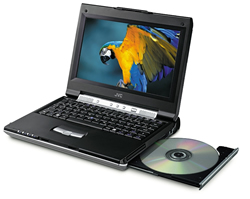 The JVC Mini Note (MP-XV841GB) is what’s known as a sub-notebook, but for such a small system it’s packed with features. What is immediately noticeable is the fantastic screen which is extremely bright and sharp and in a widescreen format (about 9 inches across diagonally) perfect for playing DVD’s on the move. The screen resolution is 1024 x 600.
The JVC Mini Note (MP-XV841GB) is what’s known as a sub-notebook, but for such a small system it’s packed with features. What is immediately noticeable is the fantastic screen which is extremely bright and sharp and in a widescreen format (about 9 inches across diagonally) perfect for playing DVD’s on the move. The screen resolution is 1024 x 600.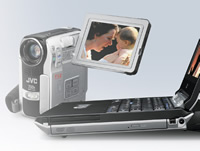 The internal drive plays DVD’s (and comes with WinDVD so you can watch them) and also writes CD’s (both CD-R and R/W). There’s 2 USB ports, an i.link (or IEEE-1394/Firewire) port, 10/100 Ethernet, a V.90 modem, microphone and line out jacks. The in-built microphone is OK for Internet chat type applications and the stereo speakers have a virtual surround sound. You can plug in an external monitor with a supplied adapter, there’s a PC Card slot and a slot for an SD memory card. Not forgetting the built-in WiFi for connecting to wireless networks or hotspots. The disk drive is 40GB split into a drive C: and D:
The internal drive plays DVD’s (and comes with WinDVD so you can watch them) and also writes CD’s (both CD-R and R/W). There’s 2 USB ports, an i.link (or IEEE-1394/Firewire) port, 10/100 Ethernet, a V.90 modem, microphone and line out jacks. The in-built microphone is OK for Internet chat type applications and the stereo speakers have a virtual surround sound. You can plug in an external monitor with a supplied adapter, there’s a PC Card slot and a slot for an SD memory card. Not forgetting the built-in WiFi for connecting to wireless networks or hotspots. The disk drive is 40GB split into a drive C: and D: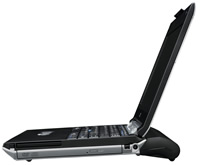 JVC include some reasonable software. Pinnacle Studio v9 which is a simple video editing package (supporting capturing video from your DV camera through the firewire port), Real Networks RealOne player, Norton Antivirus (with a 3 month subscription), WinDVD for DVD playback and CC converter a sound enhancing utility.
JVC include some reasonable software. Pinnacle Studio v9 which is a simple video editing package (supporting capturing video from your DV camera through the firewire port), Real Networks RealOne player, Norton Antivirus (with a 3 month subscription), WinDVD for DVD playback and CC converter a sound enhancing utility. Summary
Summary Shure have just released their E4c earphones. These are the in-ear type with various mouldings (sleeves) that fit on to the actual phones so you can get a comfortable fit.
Shure have just released their E4c earphones. These are the in-ear type with various mouldings (sleeves) that fit on to the actual phones so you can get a comfortable fit. While sitting on the underground you could just hear the station announcements on the public address system, but not much else. The music playing was ambient dance music and you could really make out the nuances etc. Unfortunately the only downside of blotting out everything made you realise even more how miserable everyone looked.
While sitting on the underground you could just hear the station announcements on the public address system, but not much else. The music playing was ambient dance music and you could really make out the nuances etc. Unfortunately the only downside of blotting out everything made you realise even more how miserable everyone looked.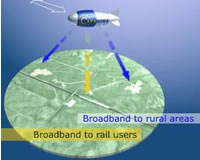 Broadband is taking off everywhere, speeds are increasing and everybody’s happy. Well almost. Broadband isn’t available to all, especially those in more rural areas.
Broadband is taking off everywhere, speeds are increasing and everybody’s happy. Well almost. Broadband isn’t available to all, especially those in more rural areas. Other approaches to HAP involve lightweight aircraft, such as the European-funded Capanina project.
Other approaches to HAP involve lightweight aircraft, such as the European-funded Capanina project.